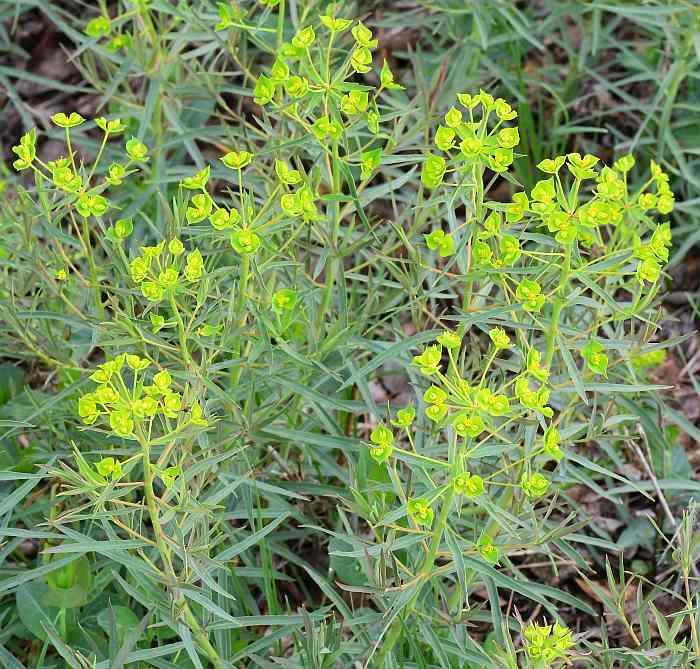Euphorbia virgata Waldst. & Kit.
Leafy Spurge

Introduced
CC = *
CW =
MOC = 1
© SRTurner
Euphorbia virgata Waldst. & Kit.Leafy Spurge | |
 |
Introduced CC = * CW = MOC = 1 |
© SRTurner |
|
Family - Euphorbiaceae Habit - Perennial forb with a deep, spreading, branched rootstock, usually also with rhizomes. Latex milky. Stem - Ascending to erect, to 90 cm, sometimes from a short-spreading base, often branched above the midpoint, the branches not flattened toward the tip, green to yellowish green, sometimes reddish-or purplish-tinged toward the base, glabrous.
Leaves - Alternate, not appearing crowded, sessile or very short-petiolate. Blades 30-100 mm long (those of the inflorescence branches 8-15 mm), unlobed, the margins entire, the surfaces glabrous, green to yellowish green, linear to narrowly oblong-lanceolate or narrowly oblanceolate, tapered at the base, rounded or abruptly short-tapered to a minute, sharply pointed tip. Leaves along the inflorescence branches opposite, kidney-shaped to broadly ovate, broadly rounded or broadly angled to shallowly cordate and somewhat clasping the stem, the terminal ones somewhat cupped around the cyathia and strongly yellowish-tinged, rounded or more commonly very broadly angled to a minute, sharply pointed tip.
Inflorescences - Terminal umbellate panicles with opposite or whorled leaves at the base and each of the 5-17 primary branches usually branched 1-4 additional times, the cyathia solitary or in small clusters at the branch tips.
Cyathia - Involucre 1.5-3.0 mm long, glabrous, the rim shallowly 4-lobed, the margin usually densely and minutely cobwebby-hairy (the hairs attached on the inner side), the marginal glands 4, 1.2-1.9 mm long, more or less kidney- to crescent-shaped, the oblong body often tapered into a pair of spreading horns, yellow to greenish yellow, lacking petaloid appendages. Staminate flowers 12-25 per cyathium. Ovaries glabrous, the styles 1.5-3.0 mm long, each divided 1/4-1/3 of the way from the tip into 2 slightly club-shaped lobes.
Fruits - 2.5-3.5 mm long, glabrous, appearing finely warty or roughened especially along the angles. Seeds 2.2-3.0 mm long, oblong-elliptic to oblongovate in outline, slightly flattened to nearly circular in cross-section, rounded or slightly flattened at the base, the surface smooth, brown to silvery gray, usually finely mottled, with a pale, somewhat flattened to slightly winglike caruncle. Flowering - May - September. Habitat - Pastures, railroads, roadsides, open disturbed areas. Origin - Native to Eurasia. Lookalikes - E. esula (see below). Other info. - This species is uncommon in Missouri, unlike the situation in much of the northern half of the continental U.S. and into Canada. There, the plant is not only common but is considered a noxious weed. Its rootstock reportedly extends 5 m deep, and it produces long-lived seeds. The plant aggressively outcompetes most native grassland species, forming dense, nearly monospecific stands. It is unpalataable to livestock, so pastures and grasslands infested with it are unsuitable for grazing. Goats and sheep, however, will eat young plants and can be used for control. Photographs taken at a highway rest stop near Drummond, Granite County, MT, 5-11-2025 (SRTurner). |